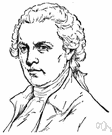Copley
Also found in: Thesaurus, Encyclopedia, Wikipedia.
Cop·ley
(kŏp′lē), John Singleton 1738-1815. American painter best known for his emotionally revealing portraits of prominent Bostonians such as Samuel Adams, John Hancock, and Paul Revere.
American Heritage® Dictionary of the English Language, Fifth Edition. Copyright © 2016 by Houghton Mifflin Harcourt Publishing Company. Published by Houghton Mifflin Harcourt Publishing Company. All rights reserved.
Copley
(ˈkɒplɪ)n
(Biography) John Singleton. 1738–1815, US painter
Collins English Dictionary – Complete and Unabridged, 12th Edition 2014 © HarperCollins Publishers 1991, 1994, 1998, 2000, 2003, 2006, 2007, 2009, 2011, 2014
Cop•ley
(ˈkɒp li)n.
John Singleton, 1738–1815, U.S. painter.
Random House Kernerman Webster's College Dictionary, © 2010 K Dictionaries Ltd. Copyright 2005, 1997, 1991 by Random House, Inc. All rights reserved.
ThesaurusAntonymsRelated WordsSynonymsLegend:
Switch to new thesaurus
| Noun | 1. |  Copley - American painter who did portraits of Paul Revere and John Hancock before fleeing to England to avoid the American Revolution (1738-1815) Copley - American painter who did portraits of Paul Revere and John Hancock before fleeing to England to avoid the American Revolution (1738-1815) |
Based on WordNet 3.0, Farlex clipart collection. © 2003-2012 Princeton University, Farlex Inc.